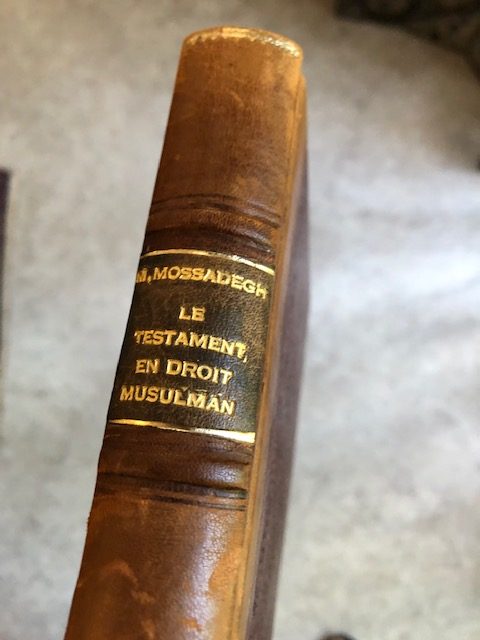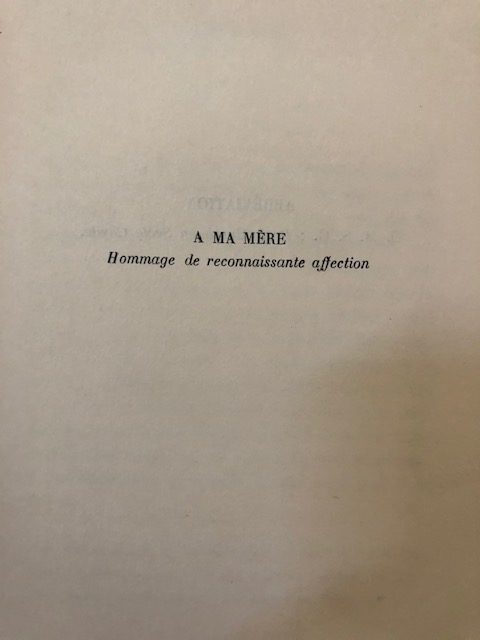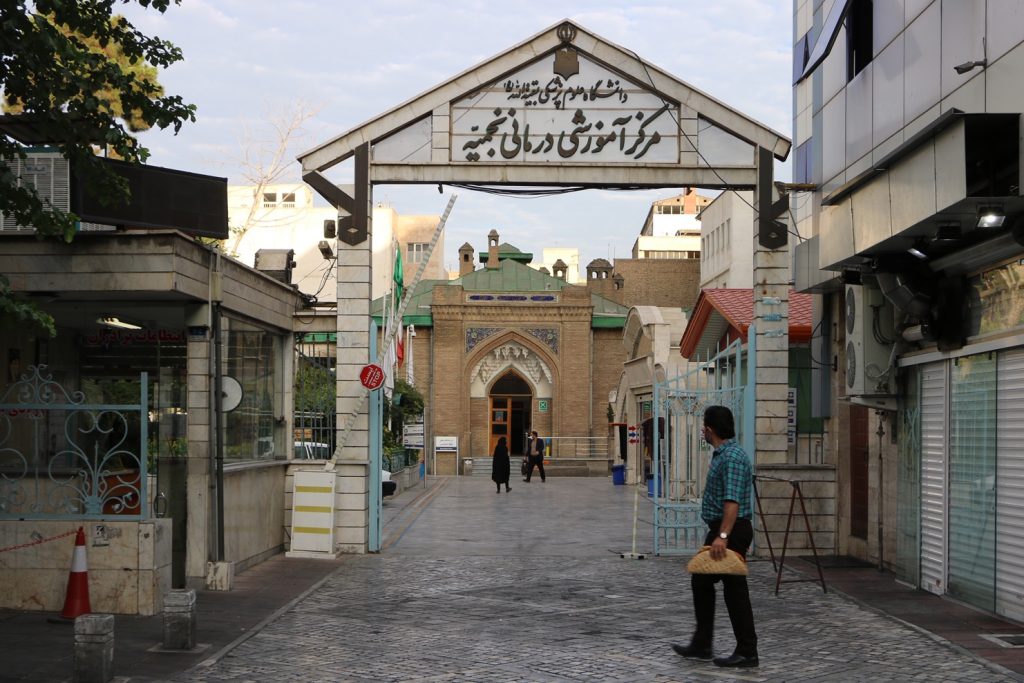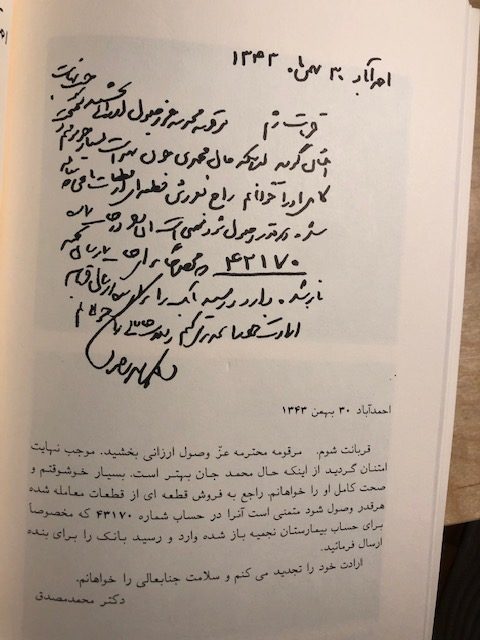On this infamous day, I have decided to write about a woman. Not just any woman but a woman who, a hundred years ago, shaped the life of man who was her son, not just any son but a son who shaped and changed the course of a country. Her name was Najm al-Saltaneh and her son was Mohammad Mossadegh.
She was an extraordinary and versatile woman. No wonder that Mohammad Mossadegh dedicated his doctoral thesis in 222 pages to his mother.
A few months ago, a very dear friend left a book for me after I had hounded him about it for years. He finally gave up and in the most gracious way left the book for me. The book in question is Mohammad Mossadegh’s thesis titled “Le testament en droit musulman (Secte Chyite)” ( published on June 11, 1914), inscribed by him and dedicated to his beloved mother, Najm al-Saltaneh: A ma mère, homage de reconnaissante affection, “To my mother, with gratitude and affection.”


Who was she and how did she shape the life of her son who at a very young age became the governor of Khorasan and then the Prime Minister of Iran, perhaps the most famous PM ever of Iran? A man who gave a speech at the United Nations defending his country and in fact won his battle at The Hague against the British.
It was she who mentored him, who taught him and who made him the compassionate, caring and law-abiding man that he became.
That is why, this time, on this August 19, I dedicate this article to Najm al-Saltaneh and all the women of Iran who are struggling for freedom. I am not going to write about this infamous day on a negative note but on a positive one, for the mother and the son made a positive contribution to Iranian society, each in their own way. Alas, their efforts were thwarted by those who did not want to see a democratic Iran. May their aspirations live forever in the hearts and minds of our people.
Who was Najm al-Saltaneh?
Malik-Taj Najm al-Saltaneh (NS) was one of the daughters of Firouz Mirza, Abbas Mirza’s son. She was born in 1853 – five years after Naser e-Din Shah’s accession as the fourth Qajar ruler – and died in 1932, seven years into Reza Shah Pahlavi’s reign. During this period, Iran underwent many changes, widespread chaos and revolution: the assassination of Naser al-Din Shah, the Constitutional Revolution, civil strife, the deposition of Mohammad-Ali Shah, World War I, the resignation of Ahmad Shah, and finally the fall of the Qajar dynasty. All these happenings and developments dramatically affected and changed Iran’s society and the social position of NS’s family. During that time, Najm al-Saltaneh also had to face numerous problems in her private life; she got married and was widowed three times. She was in sole charge of her children’s upbringing and management of the family’s finances and spending, which made her an active, determined and resilient woman.
Like other girls of her social class, she was tutored at home, and, according to tradition, key criteria for selecting a governess were age, honesty and integrity, not skill and knowledge. However, families at the time were more concerned about girls’ marriage than their education.
At that time, marriage was rather a bargain between two families, in which the future bride and groom had no role. The marriages were designed to strengthen the family’s ties and position. Property and wealth also played an influential role in marriage settlements. The interesting point in NS’s marriage was that Firouz Mirza, despite his family’s status, chose to not marry her daughter to a next-of-kin or to a member of the royal family. Clearly, he had more important issues to consider with respect to his daughter’s marriage.
In her lifetime, the year 1906 was a year of difficulties because in addition to riots and civil strikes that heralded the Constitutional Revolution, her third husband Vakil al-Molk Diba died in that year. Once again, NS became the sole guardian of her young children, and her 11-year-old Abolhassan and the issue of inheritance became the causes for her concern.
One should ask what NS thought about and how she reacted to the social changes that were transforming the lives and conditions of Iranian women She was of an earlier generation, a devout woman from an upper-class family who adhered to many ancient customs and traditions designed to provide safety and comfort. Yet she was also a smart and intelligent woman and was not indifferent to political and social trends. She did not oppose the women’s movement seeking to gain women’s rights that was part of the Constitutional Movement, in part because, having daughters and granddaughters herself, she realized that times had changed significantly and that the way she had grown up was not relevant anymore to the new generation of women. She, like everyone else, had to move forward with time. She agreed with women who not only rejected the lower status of females in society but also believed they possessed aptitude and dignity.
Farhad Diba, Dr. Mossadegh’s nephew, writes, “His mother was a liberal as well as a humanitarian, and many of Mossadegh’s beliefs in human values, as well as his understanding of the plight of the man in the street, were acquired through the teachings of of Najm al-Saltaneh. She was a devout believer and her faith in God can be traced in her son’s character.”
“His mother’s influence played an important role in Mossadegh’s life and attitudes, as well as in his approach to politics. Najm al-Saltaneh was typical of a matriarchal society of strong-minded women, who governed the affairs of their families.”
During her turbulent life, NS married three times and all three marriages ended with the death of her husband. She had five children from her marriages: Showkat al-Dowleh and Eshrat al-Dowleh from her first marriage, with Vakil al-Molk Kermani. Mohammad Mossadegh (Mossadegh al-Saltaneh) and Amina Daftar al-Moluk from her second marriage, with Vazir Daftar Ashtiani. Abolhassan Diba ( Saghat-Dowleh) from her last marriage, with Mirza Fazlallah Khan Vakil al-Molk Tabrizi.
She raised her children without their fathers, which was not an easy task at all.
Apart from her brother, NS’s source of pride and encouragement was undoubtedly her son, Mohammad Mossadegh, who owed his life to his mother’s training. He admitted that his mother had taught him that the status of an individual is determined through the hardships endured for the cause of the people.
In one of her letters addressed to Farmanfarma in Iraq, NS expressed her satisfaction with his son Mossadegh and insisted that he was well trained, which, she believed, was due to God’s will, because a fatherless child would not easily be brought up well. In another letter about her son, she wrote: “He has been interacting with people for about two years to the extent that everyone receives him well, thank God.”
Afzal al-Molk, who, at the beginning of Mozaffar al-Din Shah’s reign, was commissioned to write the history of that period, the Afzal al-Tavarikh, stated that Mossadegh was assigned, at the age of 15, to the Treasury of the Court in Khorasan.
Nine years later, when Mossadegh was 24 years old, NS was proud of him and his activities. Because of his education, personal desire and sense of nationalism, he had joined the Constitutionalists. It can be imagined that the Constitutionalists’ success in establishing the national assembly and composing the Constitution had awakened his passion. His desire for democracy was rooted in his character and lasted all his life.
NS witnessed her son’s passion and was, at the same time, worried about him. A young man who, according to his mother, was interested in cultivating land and developing villages, now turned to be a political activist and a democrat.
When the Constitutional Movement stalled and gave way to a (short-lived) period of despotism marked by authoritarianism, Mossadegh decided to leave the country together with his wife and child to study economics in France. During his stay there, he became ill for a while and had to drop out of school. On the advice of his doctor, he left Paris where the climate was unsuited to him and moved with his family to Switzerland for better weather. Later, he returned to Iran.
One of Farmanfarma’s daughters describes her aunt (Najm al-Saltaneh) as follows: “I knew her well [Farmanfarma] and I remember her visiting her brother often. She was an old and thin woman wearing a black veil. She always entered my father’s room from the men’s quarters, shook her head in response to our courtesy, and quickly went to her brother. She had a white face with big and sparkling eyes that attracted our attention. Her nose was thin and curved. She was about eighty years old. Despite her old age, she was a cheerful and agile woman, clear in thought and straight in speech. Most of the elderly nobles of her time had a determined and solid tone of speech. At that age, she was personally overseeing the construction of a hospital that still exists today and is named, after her, the Najmieh Hospital.”
Najmieh Hospital
Najmieh Hospital is located in Hafez Street in Tehran and was built under the supervision of the Russian architect Nicolai Markov who designed many important buildings in Tehran. It was the first modern hospital of Iran, a well-equipped facility with extra housing and amenities for the employees. Most importantly, it had 14 beds assigned to the impoverished who were treated free of charge. NS gave the custody of this hospital to her sons, Mohammad Mossadegh, Abolhassan Diba and, in a rare act entrusted the supervision to her eldest daughter, Zarrin Taj Hajieh Showkat al-Dowleh and later to her other daughters.

This act was done on purpose as there was a message. NS’s daughters were all raised by a very open-minded, competent and visionary mother and she wanted to make sure that her daughters were empowered.
“Najmeh’s mother, Homa Khanum, built and endowed, during her lifetime, the mosque and madrasa, which bears the name of Shahzadeh Khanom. Farmanfarma himself built and established endowments in several places in Iran. In 1923, he donated a portion of his endowment lands for the building of the Pasteur Institute of Tehran and also spent ten thousand tumans for its construction.”
“Najmieh Hospital was the first private hospital of Tehran, half of whose beds she dedicated to the poor patients. For building the hospital, she must have consulted with her two sons, Mossaddegh and Abolhassan Diba as well as her brother Farmanfarma, who had dedicated lands to the Pasteur Institute. Their encouragement played a significant role in her efforts to build this hospital. During the years that the hospital was being built, she lived in a small house in the garden of that area. Despite her old age, she supervised the construction work and at the end of each day, she paid the workers in person.”
Dr. Hedayat Matin Daftari, the grandson of Dr. Mossadegh, explains, “My great-grandmother had a list of all the family members and she would go to each house and would ask if anyone needed anything. She would then provide each and everyone with whatever they needed. Then she would ask for her carriage to go to the next house. The family member wanted to serve her tea at least but she would refuse and go on with her next venture. This was her daily routine.”
The opening of the hospital occurred in 1927. According to Farhad Diba, present at the Najmieh Hospital inauguration were of course its founder, Najm al-Saltaneh herself. Among others were :
Sardar Assad Bakhtiari
Teymourtash
Vakil-el-Molk Diba (F. Diba’s uncle)
Motamen-el-Molk
Moaven Dowleh Ghaffari
Safieh Khanoum Namazi
Fathollah (?) Khajehnouri
Hooman Khajehnouri
Hassan (later General) Arfa
Khanoum Shokat-ol-Molouk
Khanoum Effat-ol-Molouk
The first three were all killed on the orders of Reza Shah.
The direction and administration of the hospital was given to Dr. Yousef Mir who was originally from Yerevan and who had gone to Lausanne to study medicine. When he returned from his studies, he worked in the army hospital in Tehran and eventually married NS’s granddaughter. He stayed on as the director for many years. Later, Dr. Hossein Moaven became the director. At the order of Reza Shah, he was removed, taken to prison and later killed there. Dr. Mahmoud Mossadegh, great-grandson of Dr. Mossadegh, is still a trustee of the hospital.
When Dr. Mossadegh became ill (diagnosed with cancer of the mouth) he spent his last days there. He refused to leave Iran and be treated by foreign doctors. “I am the servant of these people and my lot is no different than theirs. I will use all the treatments that are available in this country and refuse to go abroad. Plus such action is an insult to our own Iranian doctors.”
A wing of the hospital was also financed by the late Haji Shamshiri ( the owner of the famous Shamshiri restaurant) who was a staunch supporter of Dr. Mossadegh. Abolhassan Diba also contributed 30 percent of his company’s share to build a more modern and elaborate wing.
My own father oversaw some of the finances of the hospital and would report back to Dr. Mossadegh in Ahmad Abad, his residence and place of exile. My mother visited the hospital many times, taking some of the people who were ill and indigent. Days before Dr. Mossadegh passed away, both my parents visited him at the hospital. A very touching story goes that Shahidi, one of the Savak agents who was present at all times in Ahmad Abad and had become an admirer of Dr. Mossadegh, wrote a letter and gave it to my father to take to Dr. Mossadegh while he was lying ill in bed.

He said in the letter, “Please come back to Ahmad Abad; we miss you dear Dr. Here is your home. We need you here.” He had cried while giving this letter to my father.
There was a plaque on the very front of the door of the hospital dedicated to Najm al-Saltaneh.
Today, this hospital has been taken over by the Revolutionary Guards. The plaque is now covered with a cloth. The hospital official I spoke to in recent days, explained that the plaque is not covered but has been decorated with a cloth. He also explained that anyone can be treated at the hospital and the poor are still treated freely. According to him, Najmieh hospital is now one of the best hospitals in Iran for women and obstetrics. I asked that he take a photo of the plaque and send it to me. He apologized profusely, explaining that he is not allowed to take photos for he may lose his job.
Najm-al Saltaneh died at the age of 79 in 1932. Her death was a devastating blow to her brother, Farmanfarma. Fortunately, she was not alive when Nosrat-al-Dowleh was killed on the orders of Reza Shah. She was not alive when her beloved son, Mohammad Mossadegh, was arrested and sent to exile by Reza Shah. She would have never imagined that her son would be brought to trial for “treason” under the rule of Mohammad Reza Shah.
The only remaining member of the family who saw her and who is still alive is her great-grandson, who was ten years old at the time. I spoke to him via phone. He is the director of Mossadegh Foundation in Geneva, Switzerland.
Dr. Bayat gave some very interesting stories which he remembered. “My grandmother was a stern and authoritative woman. She would come to our house and always had coins in her pockets and would give these to the children of the family and would tell them to go buy ice cream. She didn’t smile much but was very kind.
A funny episode I remember is when one time at four in the morning she came to our house and in an upsetting voice asked us, why did you guys send fleas to my house. Now I can’t even go back there. Then she stayed and started talking and engaging with us, telling us stories and so on. I knew that the flee story was made-up. She just wanted to be with us!”
“Her second husband loved her very much, so much so that in his office, where important people would come to discuss matters, there was a curtain and behind there, his wife, my grandmother, would sit and listen to the conversations. Then she would give advice to her husband about all issues. She was a very engaged woman in all aspects of life.
She would get up early in the morning and oversee the construction of the hospital and even make the payments to the workers.”
“Dr. Mossadegh adored his mother and listened to her advice as well. But she never really forced him to engage in politics. She was occupied with her philanthropy and her faith.”
I asked him if there were any photos he could send me. He replied, “I don’t really have any photos of her that you have not seen. But my mother who had come from abroad and had bought a camera took the famous photo of her (on the cover of this article) and then she took it to Europe and had someone paint it in color. That portrait hung in the office at Najmieh Hospital. I don’t know whether it is still there or not.”
Neither Dr. Mohammad Mossadegh nor his brother Abolhassan Diba, who were trustees of the hospital, ever accepted any money from the hospital.
Najm al-Saltaneh, the mother of the man whose democratically elected government was toppled on this very day, is buried in Karbala, Iraq.
May her memory live on.
***
Sources:
Mansoureh Ettehadieh (Nezam Mafi), The Life of Malek Taj Khanum Najm al-Saltaneh, Tehran, Iran, 1387/2008.
Farhad Diba, Mossadegh, A Political Biography, Beckenham, Kent, 1986.
Author’s Personal interviews.
With special gratitude to MM for helping me with some of the translations.
Letter addressed to Prince Farmanfarma:“My Dear, we have not heard from each other for months and years now, days and months pass without receiving a letter from you. Even if we shut down communication by closing the caravan trail, being apart and not having any news of each other for months and years, the pain will not get any less. I have no wish to bother you by sending you letters if this is against your wish. Anyway, I hope you are healthy and safely performing your pilgrimage at the shrine of the Imam in Iraq. Regarding my condition, I must say that I thank God for His blessings. In fact, I do not care about worldly affairs anymore and I have become a full-fledged dervish, outwardly and inwardly. Even if I am not a dervish, the world has turned me into one, because my wealth has come to nothing, yet I am not concerned about any of it any longer. I am waiting for the King’s entourage to come, but I do not rely on anyone but God and the souls of my deceased ancestors to resolve my issues. Nazem al-Dowla was ill and went to Istanbul for treatment. From there, he wrote a letter saying that his condition had improved. God willing, His Highness Nosrat al-Dowla and the other gentlemen ae in perfect health. I have nothing more to say.” -NS. ( Date unknown)






